| |
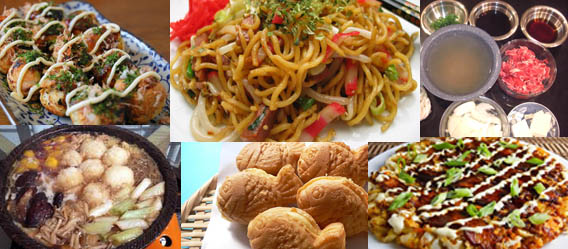
Walking along the streets of Osaka, Japan, one may suddenly get a whiff of a tantalizing smell: a buttery smell of grilled batter and the smell of sweet Teriyaki sauce on the famous street snack of Osaka known as Takoyaki. Popular all across Japan and now exported to many parts of the world, Takoyaki is just one many delicious Japanese snack and dishes that utilize a cooking technique known as “Yaki” originating from the word “Yaku”, meaning to fry or to grill.
Yaki cooking comes in a wide variety of styles and has created a varied repertoire of yaki dishes. Most of these yaki dishes differ in taste, look and style but all of them employ the Japanese griddle. Much like the Western griddle, the Japanese griddle is usually a large flat metal plate made from aluminum, stainless steel, or cast iron. In order to create the wide variety of yaki dishes, many yaki griddles have evolved for specific yaki snacks.
This month’s newsletter will introduce the various popular yaki dishes and the cooking utensils employed to create them.
Teppanyaki
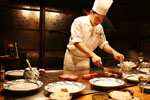
A style of Japanese cooking that uses a griddle. The word Teppanyaki is made up of the words “Teppan” meaning metal plate and “yaki” meaning to grill, broil or to pan fry. Teppanyaki are commonly cooked on propane heated surface metal grill, and the cooking is usually done by a chef in front of guests.
Typically, beef, shrimp, scallops, lobster and chicken are cooked on the flat top Teppanyaki griddle. In Japanese style Teppanyaki, noodles are also cooked, known as yakisoba, a type of pan-fried noodle. Side dishes of mung bean sprouts and zucchini are commonly offered along with dipping sauces.
If you have never had teppanyaki, you are missing out on a treat. Teppanyaki chefs are often great live entertainers wowing guests not only with the great taste of teppanyaki dishes but with their acrobatic cooking styles.
Okonomiyaki
 Known as the Japanese pancake, okonomiyaki comes from the Japanese words “Okonomi” meaning what you like, or what you want and the root word “yaki” for grilled. Originating from Kansai and Osaka regions of Japan, okonomiyaki is a delicious savory treat that usually contains grated yam, dashi, eggs, shredded cabbage, green onion, meat, octopus, squid, vegetable, kimchi, mochi and cheese. All that is grilled on a griddle and is topped with octopus flakes and teriyaki sauce.
Known as the Japanese pancake, okonomiyaki comes from the Japanese words “Okonomi” meaning what you like, or what you want and the root word “yaki” for grilled. Originating from Kansai and Osaka regions of Japan, okonomiyaki is a delicious savory treat that usually contains grated yam, dashi, eggs, shredded cabbage, green onion, meat, octopus, squid, vegetable, kimchi, mochi and cheese. All that is grilled on a griddle and is topped with octopus flakes and teriyaki sauce.
Using a teppan (metal plate) or a pan, the batter is grilled and the fillings and toppings are added. A variant of okonomiyaki includes yakisoba or udon where pan-fried noodles are included in the okonomiyaki. It is known as the modern okonomiyaki.
Yakisoba
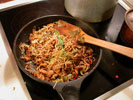
Yakisoba comes from the words “Yaki” meaning to grill or to cook, and “soba” the wheat based noodles often found in Japanese cuisine. Yakisoba is very similar to the Chinese version of fried noodles: Chow Mein. Although the word “soba” refers to Japanese buckwheat noodles, most yakisoba are in fact not made from soba, but from a form of noodles similar to ramen that is made from wheat flour.
Yakisoba usually includes bite sized bits of pork, and vegetables (usually carrots, cabbage, and onions) and is seasoned with salt and yakisoba sauce. Another version known as Yakiudon uses the white udon noodles as a replacement of the yellow wheat flour noodles.
Yakisoba or Yakiudon are usually prepared over a teppan (metal plate) or a pan. Great with beer, they were very popular in Okinawa and with U.S service men who were stationed on the island.
Sukiyaki
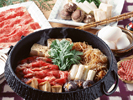
Unlike the other grilled dishes, Sukiyaki is a soup based dish, and is prepared in the nabemono (hot pot) style. It is a popular winter dish. Imagine sitting in front of a boiling pot with steaming goodies on a cold winter day, with a boiling pot full of delicious ingredients.
Sukiyaki usually includes thinly sliced beef, tofu, and vegetables. It is usually placed inside a shallow pot along with a broth made from soy sauce, sugar and mirin (a Japanese condiment similar to a kind of sweet sake). Ingredients of Sukiyaki are usually dipped in a bowl or raw beaten egg.
Sukiyaki is usually enjoyed in a cast iron pot on top of a heated metal plate to bring the ingredients in the pot to a boil. Sukiyaki can also be prepared on top of a mini stove.
Yakitori
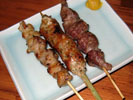
Yakitori can be translated into “Yaki” grilled, “Tori” fowl. It is a popular Japanese street food and is prepared by placing meat on a bamboo skewer and grilling it with delicious tare sauce that is made up of mirin, soy sauce, and sugar. The marinated meat is then placed over an open fire, usually over charcoal, until it is grilled to a lovely golden brown.
Yakitori is sometimes also known as Kushiyaki. “Kushi” meaning skewered, and “yaki” for grill, and the two terms can be used interchangeably. Although most yakitori is made from grilled chicken meat, yakitori can also be made from a variety of other kinds of chicken parts. Options include: chicken heart, liver, chicken gizzard, chicken skin, chicken wing, chicken tail, or chicken cartilage.
Yakiniku
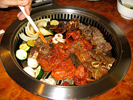 Or Grilled Meat, is often seen as a Japanese variety of Bulgogi. Usually prepared over an open charcoal fire, yakiniku is most often a form of grilled beef or offal. Often, pork and chicken is also used in the preparation and enjoyment of yakiniku dishes.
Or Grilled Meat, is often seen as a Japanese variety of Bulgogi. Usually prepared over an open charcoal fire, yakiniku is most often a form of grilled beef or offal. Often, pork and chicken is also used in the preparation and enjoyment of yakiniku dishes.
Typically in a Yakiniku restaurant, plates of raw plate are placed on table for diners to cook over an open fire in a grill built into the restaurant’s table. Grilled Yakiniku meat is usually enjoyed with tare sauce made from sugar, soy sauce and mirin.
Takoyaki
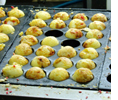 Meaning Grilled Octopus, Takoyaki originated in Osaka, and is a tasty Japanese street snack in the shape of round grilled batter balls. Filled with whole baby octopus, or tempura bits, Takoyakis are very similar to Danish Æbleskiver and are often described as savory pancake balls. Along with the octopus and tempura stuffing, takoyakis are also filled with spring onion and pickled ginger.
Meaning Grilled Octopus, Takoyaki originated in Osaka, and is a tasty Japanese street snack in the shape of round grilled batter balls. Filled with whole baby octopus, or tempura bits, Takoyakis are very similar to Danish Æbleskiver and are often described as savory pancake balls. Along with the octopus and tempura stuffing, takoyakis are also filled with spring onion and pickled ginger.
Takoyakis today are also brushed with a light coat of takoyaki sauce, mayonnaise, and topped with green laver and bonito (a type of fish) flakes. Beyond being an adorable sight, they are addictively delicious snacks that are made from specially shaped takoyaki pans.
Takoyaki pans are shaped in circular moulds and batter can be poured into the circular hollows and grilled to produce perfect takoyaki balls.
Obanyaki
 Obanyaki is a type of Japanese street food. A sweet Japanese pancake shaped in a circle, Obanyaki are dough grilled in an obanyaki pan. Filled with sweet azuki bean paste, vanilla custard, or cheese, or chocolate, obanyaki are sometimes also known as Imagawayaki and are often found at festivals.
Obanyaki is a type of Japanese street food. A sweet Japanese pancake shaped in a circle, Obanyaki are dough grilled in an obanyaki pan. Filled with sweet azuki bean paste, vanilla custard, or cheese, or chocolate, obanyaki are sometimes also known as Imagawayaki and are often found at festivals.
Savory forms of obanyaki can also sometimes be found with curry fillings, and different meat and vegetable fillings. Sometimes, obanyaki also comes in the shape of a fish. Made from elaborately decorated obanyaki pans, these fish-shaped obanyakis are also known as Taiyaki.
Create your own delicious Yaki dishes
After reading about all these delicious yaki dishes, you don’t have to dream of walking down a crowded Japanese street fair in order to try these tasty snacks, you can now create your own.
At Mrs. Lin’s Kitchen, we carry a variety of Japanese pans, grills and plates so you can now whip up the yaki snack you want to try. Try your hand at making takoyaki with our takoyaki pans, or create your very own taiyaki with our taiyaki maker. For those who crave a taste of sukiyaki hotpots, our iron sukiyaki pan is the perfect choice. We even carry a shabu-shabu hibachi grill base so that you can now bring the open fire charcoal grill used to make Yakitori in the comfort of your own home. |
|
 |
OUR 2011 NEWSLETTERS
Japanese Yaki Cooking: Fun with the Japanese Griddle
Learning all about the Chinese wok
Obon Festival:Remembering the Dead and Celebrating Family Ties
Asian Ceramics-the Exquisite Asian Art form
Asian Alcohol-An Enchanting Journey of flavor, culture and history (Part II)
Asian Alcohol-An Enchanting Journey of flavor, culture and history (Part 1)
The Way of the Samurai: Exploring Japan's Revered Noble Warriors
Chinese New Year 2011: The Year of the Metal Rabbit
Red Envelopes: Asia's Ancient and Auspicious Gift-Giving Tradition
NEWSLETTER ARCHIVES
2012
2011
2010
2009
2008
2007
2006
2005
2004
2003
2002
2001
MAY WE SUGGEST:
Takoyaki Pan (6096)
Shabu Shabu/ Hibachi Grill Base (6031)
Takoyaki Pick (6216)
Lucky Bean Cake Taiyaki Maker (6199)
Obanyaki Pan
(6097)
|
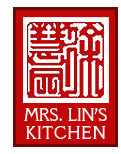


 Known as the Japanese pancake, okonomiyaki comes from the Japanese words “Okonomi” meaning what you like, or what you want and the root word “yaki” for grilled. Originating from Kansai and Osaka regions of Japan, okonomiyaki is a delicious savory treat that usually contains grated yam, dashi, eggs, shredded cabbage, green onion, meat, octopus, squid, vegetable, kimchi, mochi and cheese. All that is grilled on a griddle and is topped with octopus flakes and teriyaki sauce.
Known as the Japanese pancake, okonomiyaki comes from the Japanese words “Okonomi” meaning what you like, or what you want and the root word “yaki” for grilled. Originating from Kansai and Osaka regions of Japan, okonomiyaki is a delicious savory treat that usually contains grated yam, dashi, eggs, shredded cabbage, green onion, meat, octopus, squid, vegetable, kimchi, mochi and cheese. All that is grilled on a griddle and is topped with octopus flakes and teriyaki sauce.


 Or Grilled Meat, is often seen as a Japanese variety of Bulgogi. Usually prepared over an open charcoal fire, yakiniku is most often a form of grilled beef or offal. Often, pork and chicken is also used in the preparation and enjoyment of yakiniku dishes.
Or Grilled Meat, is often seen as a Japanese variety of Bulgogi. Usually prepared over an open charcoal fire, yakiniku is most often a form of grilled beef or offal. Often, pork and chicken is also used in the preparation and enjoyment of yakiniku dishes.  Meaning Grilled Octopus, Takoyaki originated in Osaka, and is a tasty Japanese street snack in the shape of round grilled batter balls. Filled with whole baby octopus, or tempura bits, Takoyakis are very similar to Danish
Meaning Grilled Octopus, Takoyaki originated in Osaka, and is a tasty Japanese street snack in the shape of round grilled batter balls. Filled with whole baby octopus, or tempura bits, Takoyakis are very similar to Danish  Obanyaki is a type of Japanese street food. A sweet Japanese pancake shaped in a circle, Obanyaki are dough grilled in an obanyaki pan. Filled with sweet azuki bean paste, vanilla custard, or cheese, or chocolate, obanyaki are sometimes also known as Imagawayaki and are often found at festivals.
Obanyaki is a type of Japanese street food. A sweet Japanese pancake shaped in a circle, Obanyaki are dough grilled in an obanyaki pan. Filled with sweet azuki bean paste, vanilla custard, or cheese, or chocolate, obanyaki are sometimes also known as Imagawayaki and are often found at festivals. 